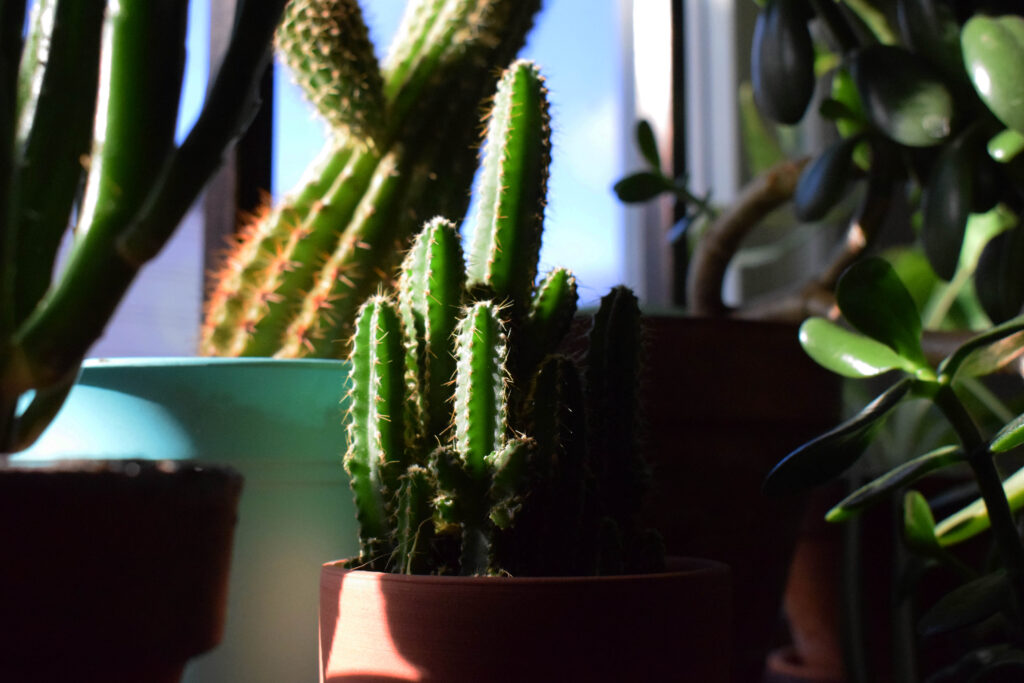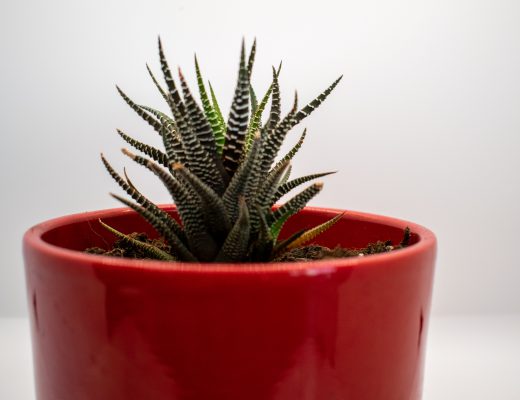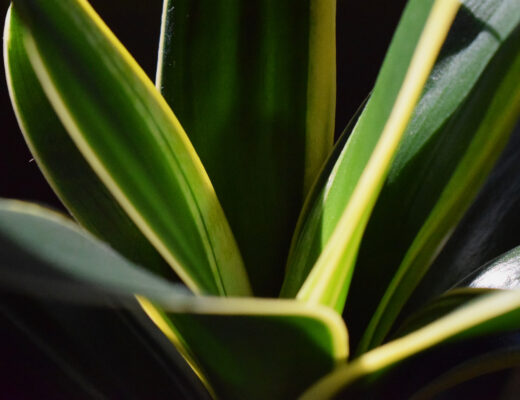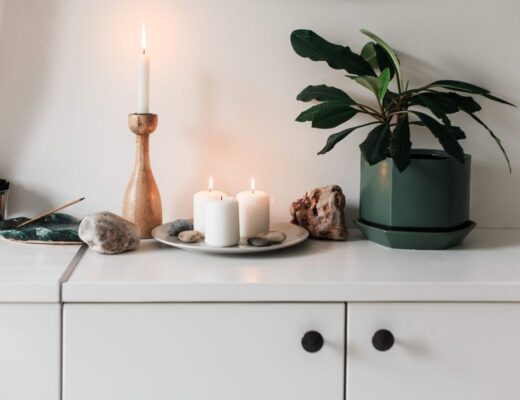
Hey there! If you’re anything like me, you’ve probably fallen head over heels for the charming world of cacti. These prickly yet fascinating plants have a unique charm that’s hard to resist. But, caring for cacti is more complex than leaving them in a corner and forgetting about them. With so many unique varieties, if your plant collection is entirely cacti, you can have a ton of individual plants!
While I may have started with a Jade plant and a Hawarthia, it didn’t take long for cacti to join my collection! One birthday while I was attending university, I went to dinner with my aunt, and she got me three different cacti! I got two moon cacti, a yellow one and a red one, which I had for about 3 years before the tops died. The third, which I still have is a Saguaro Cactus (I think!), this one is a bit hard to identify since there are a lot of similar-looking cacti out there! As I delved into the world of these resilient succulents, I realized there’s much more to caring for cacti than meets the eye. In this comprehensive guide, we’ll explore the ins and outs of cactus care, covering everything from watering needs to sunlight requirements and even how to safely re-pot these spiky wonders.
Watering Needs
Now, let’s dive into the crucial topic of watering. Cacti, true to their desert origins, have earned a reputation for being drought-tolerant. They can go for weeks without water, making them ideal for those who might forget to water their plants occasionally. However, moderation is key. Despite their hardiness, cacti still require a good drink every now and then.
When it comes to watering, less is more. Always allow the soil to dry out completely between waterings. Stick your finger about one-two inches into the soil (depending on if it is a large or small cactus) – if it’s dry, it’s time to water. Overwatering is a common mistake that can lead to root rot, so resist the urge to shower your cactus with affection too often.
I once read that a cactus does not need more than a soda cans worth of water a year to survive… which would be a fun tidbit if it were true! It’s important to remember when watering your cactus, to make sure all of the soil is wet, and then from there wait for it to dry out. This amount of water will let your cactus grow, instead of barely hanging on because it is not getting enough water!
Pot Needs
Selecting the right pot for your cactus is paramount. Cacti thrive in well-draining soil and containers that mimic their native desert habitat. Opt for pots with drainage holes to prevent water from pooling at the bottom, a situation that can spell disaster for your cactus roots.
Consider the size of the pot as well. Cacti generally appreciate a snug fit, so choose a container that’s just slightly larger than the root ball. This not only helps prevent overwatering but also provides stability for those tall, spiky friends who might become a bit top-heavy over time.
Now, let’s talk aesthetics! One of my favourite types of pots to accompany a cactus is the timeless terracotta or warm brown-coloured pot. There’s something about the earthy tones that complement the vibrant green hues of cacti, creating a visual harmony reminiscent of their native desert environments. Just today I picked up this beautiful black and brown pot from House of Plants! However, regardless of the pot’s colour, always prioritize functionality. Ensure it has proper drainage holes, allowing excess water to escape, or consider planting your cactus in a nursery pot within the decorative ceramic pot if drainage is lacking. This way, you strike the perfect balance between style and the well-being of your prickly companions.
Sunlight Requirements
Now, let’s shed some light on the matter – quite literally. Cacti love basking in bright sunlight. Position them near a south or west-facing window for optimal growth. These sun-loving plants require at least 6 hours of sunlight daily, so don’t shy away from exposing them to the sun’s rays.
If you’re cultivating cacti indoors, consider rotating them every few weeks to ensure all sides receive equal sunlight. This simple practice promotes even growth and prevents your cactus from leaning toward one direction, chasing the sunlight. Outdoor cacti should be acclimated gradually to direct sunlight to avoid sunburn. Remember, a happy cactus is a sun-kissed cactus!
Now, let’s address a common issue for indoor cactus enthusiasts without ample window access. If your cactus doesn’t receive sufficient light, you might notice it reaching and leaning toward the window. This phenomenon is often referred to as a plant getting “leggy.” Essentially, your cactus is stretching and elongating its stem in search of more light. If not addressed promptly, your cactus may lean increasingly until it reaches a tipping point and falls over. To avoid this, consider supplementing natural light with artificial grow lights, ensuring your cactus stays upright and healthy even in less-than-ideal lighting conditions. Don’t have the proper light for cacti? Check out these 10 low-light houseplants!
Different Popular Types
Cacti come in a dazzling array of shapes and sizes, each with its own unique personality. Let’s explore a few popular types that might captivate your attention:
- Saguaro (Carnegiea gigantea): Symbolizing the American Southwest, these towering giants can reach up to 60 feet in height. Not the best choice for small apartments, but perfect if you’ve got some serious space and sunlight.
- Barrel Cactus (Echinocactus grusonii): With its round, ribbed shape, the barrel cactus adds a touch of whimsy to any collection. Known for its golden spines and slow growth, it’s a low-maintenance option for cactus enthusiasts.
- Christmas Cactus (Schlumbergera): Breaking the mold with lush, flat stems and vibrant blooms, the Christmas cactus enjoys a bit more humidity and indirect sunlight than its arid counterparts.
- Prickly Pear (Opuntia): With flat, paddle-shaped stems adorned with glochids, the prickly pear is a hardy and visually striking choice. It’s a favourite for xeriscape gardens and is even edible – those pads make for a unique culinary experience!
Origin
Cacti boast a fascinating and storied history deeply entrenched in the arid landscapes of North and South America. These remarkable plants have not just survived but thrived in some of the most inhospitable environments on Earth. Their resilience and ability to adapt are nothing short of awe-inspiring.
The journey of cacti begins in the vast deserts of Arizona, where the scorching sun and arid conditions create an environment that would seem inhospitable to most plants. However, cacti have evolved ingenious mechanisms to not only withstand these harsh conditions but to excel in them. Their secret lies in specialized water-storing tissues and unique structural adaptations that allow them to minimize water loss, a precious commodity in the arid landscapes they call home.
Venture further south, and you’ll find cacti making their mark in the rugged terrains of the mountains of Peru. Here, they have carved out a niche for themselves, showcasing their adaptability in diverse ecosystems. The ability of cacti to thrive in such varying environments speaks volumes about their evolutionary prowess and their capacity to endure extremes of temperature, elevation, and climate.
As we delve into the origins of cacti, we uncover a tale of survival, resilience, and a deep connection with the natural world. From the iconic saguaros standing sentinel in the Sonoran Desert to the delicate but hardy prickly pears scattered across the high-altitude landscapes of the Andes, cacti have truly embraced their roles as survivors in some of the world’s most challenging terrains.
Safely Repotting Your Cactus
Now, let’s tackle the somewhat prickly subject of repotting. While cacti don’t need frequent repotting, it’s essential to refresh their soil and provide a bit more room when they outgrow their current homes. Follow these steps to safely repot your cactus without the drama:
- Choose the Right Time: Spring or early summer is the best time to repot your cactus. This allows them to recover and establish new roots before the dormant winter season. If you keep your cacti inside this period is less important, however still ideal. While your cacti may not have to deal with cooler conditions, it still has a lack of light to contend with in winter!
- Gather Your Supplies: Arm yourself with thick gloves to protect your hands from those spiky defences. You’ll also need a new pot, fresh cactus soil, and a trowel.
- Gently Remove the Cactus: Carefully turn the pot upside down and tap the bottom to loosen the soil. Cradle the cactus between your fingers and gently pull it out. Be cautious not to damage the roots or prick yourself.
- Inspect the Roots: Check for any signs of rot or disease. Trim away any dead or damaged roots with sterilized scissors or pruning shears.
- Repot with Care: Place a layer of fresh cactus soil in the new pot. Set the cactus in the center, adjusting the soil level as needed. Fill the remaining space with soil, leaving about an inch from the top to prevent water overflow.
- Water Sparingly: Allow the newly repotted cactus to settle for a day or two before watering. This gives any root injuries a chance to heal without the risk of infection.
Conclusion
Caring for cacti is a delightful and rewarding journey, blending the appreciation for unique aesthetics with the sheer joy of nurturing some of nature’s most resilient plants. It’s not just about having green companions in your living space; it’s about understanding the intricate balance they strike in their native environments and replicating that harmony in your care routine. Mastering the art of moderation in watering becomes a dance between providing just enough hydration to sustain your cactus without drowning it. This careful choreography ensures that your cactus not only survives but thrives, showcasing its distinctive beauty with robust growth and vibrant health.
The journey of caring for cacti extends beyond the basics of water and soil. Finding the perfect pot becomes a quest for both functionality and style. As you explore the myriad options, from classic terracotta to sleek ceramic designs, you’re not just selecting a vessel for your plant – you’re curating an aesthetic that complements your taste and enhances the overall ambiance of your space.
Basking in the sunlight takes on a whole new meaning as you witness your cacti responding to the warmth and brightness. It’s a daily connection to the rhythms of nature, a reminder that your efforts in creating an ideal environment contribute to the flourishing of these spiky wonders. So, go ahead, embrace the spiky side of life, revel in the intricate dance of care, and watch with satisfaction as your cacti flourish in all their desert glory. Happy gardening!
Discover more from Savage Gardener
Subscribe to get the latest posts sent to your email.






1 Comment
Dorothy
January 7, 2024 at 12:55 pmBeautifuly written and very interesting background about cactus!